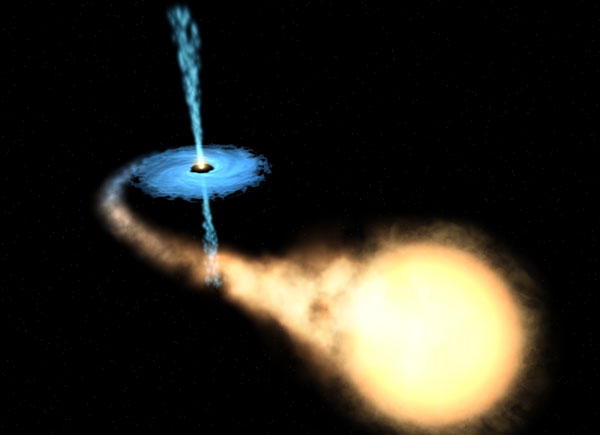A Rapidly Spinning Black Hole with a Warped Disk
AAS Nova | August 2, 2018
How to Spot Black Holes
Stellar-mass black holes lurk throughout our galaxy — but their darkness makes them understandably difficult to spot. Because these small beasts don’t emit light, we have few observations of the stellar-mass black holes around us, limiting what we can learn about these mysterious objects and their behavior.
One way that we can observe such black holes is if they exist in an X-ray binary, a binary consisting of a black hole and a donor star. In X-ray binaries, material that is siphoned off the donor star goes to feed the black hole, forming an accretion disk around the black hole as it falls in. As the material in the accretion disk spirals inwards, it radiates strongly in X-rays — resulting in emission that we can observe, even though the black hole itself emits no radiation.
But what is the structure of this accretion disk? How far in toward the black hole does it extend? How fast does the black hole spin at its center? These are among the many questions to which scientists are still seeking answers. In a new study, astronomer Jon Miller (University of Michigan) and collaborators present new views of an X-ray binary that may provide some clues.
Eyes on a New X-Ray Source
Miller and collaborators present new observations of the X-ray binary MAXI J1535-571 made with the Neutron Star Interior Composition Explorer (NICER), an X-ray telescope recently installed on board the International Space Station.
NICER’s observations indicate that the black hole in this binary is likely spinning very rapidly — at more than 99% of the maximum possible speed! The light we observe from MAXI J1535-571 appears to include contributions both from the black hole’s accretion disk and from the corona of very hot gas that lies above the disk. Light from the corona reflects off of the accretion disk, providing us with more information about the structure of the disk.
By modeling the observations, Miller and collaborators show that the disk extends nearly all the way inwards to what’s known as the innermost stable circular orbit, the closest stable orbit you can have to a black hole.
Reflections of a Warp
Lastly, the authors point out an additional feature in MAXI J1535-571’s spectrum: a narrow emission line that they suggest might be caused by a warp in the disk, such that the disk no longer lies flat. The warp would locally change the profile of the accretion disk, causing more light from the corona to be reflected to us from that point.
The presence of this potential warp, the extent of the disk, and the spin of the black hole are all pieces of the puzzle that will help us better understand the behavior of stellar-mass black holes feeding off of companions. And we can look forward to the high sensitivity of NICER — which made these observations possible — continuing to produce exciting results in the future!
_______________________________________________
A little technical...but interesting to see how they observe black holes indirectly. - ilan
 |
 |
|
|||||||||||
 |
 |
||||||||||||
|
|
|
|
|
|
|
||||||||
 |
|
|
|
|
|
 |
|||||||
|
|
|
|
|||||||||||
|
|
|||||||||||||
|
|
|
|
|
|
|
|
|
|
|
|
|
|
|
Results 1 to 1 of 1
Thread: How to Spot Black Holes
-
08-05-2018, 12:18 PM #1
How to Spot Black Holes
Beginner's Guide for Rocket, NFPS and IKS66...
http://iptvtalk.net/showthread.php?2...-you-should-do
Kodi Options for Rocket, NFPS and IKS66...
http://iptvtalk.net/forumdisplay.php?71-Kodi
Check the Announcement Section...
http://iptvtalk.net/forumdisplay.php...-Announcements
Similar Threads
-
Black holes are like a hologram
By ilan in forum The Universe in ReviewReplies: 2Last Post: 06-06-2020, 01:50 PM -
Why clouds form near black holes
By ilan in forum The Universe in ReviewReplies: 0Last Post: 05-19-2020, 02:20 PM -
Black Holes
By ilan in forum The Universe in ReviewReplies: 0Last Post: 01-12-2020, 01:55 PM -
All Black Holes are not created equal
By ilan in forum The Universe in ReviewReplies: 0Last Post: 01-19-2019, 01:18 PM -
Spot channel black out
By tuan170 in forum IPTV Private Server (NFPS)Replies: 0Last Post: 08-27-2017, 04:49 PM







 Reply With Quote
Reply With Quote